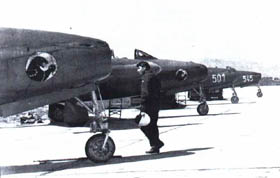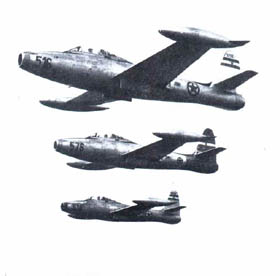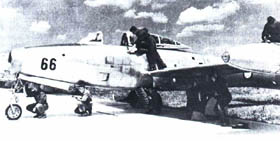On June, 1953 at Batajnica airport landed a group of
eight Thunderjets flown over from a base in West Germany. It was the beginning of the
delivery under the agreement of military aid from West countries to Yugoslavia (Mutual
Defense Aid Program - MDAP).
The
then allies of the Balkan treaty, Greece and Turkey, got F-84G some time earlier, and on
May 9,1952 the neighboring Italy was presented first 19 planes of this type.
The
first eight F-84G for the 'Yugoslav Air Force were, according to the then ruling USAF
standards in natural aluminum color, while the first part of the nose in front of the
pilot was in olive drab (to avoid reflection).

The
planes had American markings of that period - on the wings there was asymmetrically placed
inscription USAF and emblem USAF on the fuselage also. On the vertical stabilizer (tail)
there was the inscription United States Air Force and serial number. The last three digits
of that number were in combination with letters FS on the front part of the nose
(so-called buzz-numbers) for example 52-29941 , FS-994. All the letter-number markings
were in black color.
Some
of the planes delivered in 1953 were painted in so-called arctic red paint scheme. Some
surfaces of these Thunderjets were painted in red, such as the complete rear part of the
plane, ailerons, some parts of wings and tip-tanks. Such paintings was kept also after
putting Yugoslav markings instead of the American ones in accordance with the then
existing way of marking: the roundel JRV (Yugoslav Air Force) was on the fuselage and on
the lower surfaces of wings, diameter 50 cm, the Yugoslav flag was in the middle of the
vertical stabilizer over the American serial number, while the black, two-digit small
dimension squadron numbers were put on the nose, behind air-intake. Serial numbers of the
Yugoslav Air Force (JRV) from 10501 onwards, were put over the tricolor flag, although in
the beginning quite a number of the planes did not have them.
Some
F.B4G were put into action unmarked, because after removing USAF markings did not get
those of Yugoslav Air Force and a special "confusion" was created by those
Thunderjets flown a short time with USAF markings.

PAINTING
In
the second half of the fifties fighters F-86E arrived and F-84G started to lose its role
as a fighter and more and more was assuming a role as a fighter-bomber, and later on as a
reconnaissance aircraft.
This
process was quicken in the period 1959-60 with further acquisition of F-86E Sabre and by
introducing them to aviation regiments instead of Thunderjets.
This
period is characterized by acquisition of Thunderjets from the Greek Air Force, which had
withdrawn, till the end of 1957 the greater part of their F-84G from the use after getting
new F-86G Thunderstreaks. These Thunderjets arrived (mainly) unpainted, as had been
used in the Greek Air Force.
|
|
The new defense concept brings also the new camouflage
painting for the F-84G and according to the aviation - technical regulation, it seems as
follows:
- upper surfaces were to be in light gray - camouflage sports in dark green
- lower surfaces in light blue
Dark green surfaces were in form of big sports which were spreading across the
fuselage and wings.
In
the meantime also a strange scheme appeared in this period, where these camouflage spots
were small, in shape of stains deposited asymmetrically over the whole upper surface of
the plane and the bottom of the vertical stabilizer (this scheme is very evident in planes
from the 88'" bomber regiment). The squadron numbers were black, and the rest of
positions for marking were the same. This original painting did not stay for a long time,
for later on a new type of painting was initiated: land forces camouflage painting, Which
has brought also new colors to the scheme, so that the upper surfaces of the plane were
painted in gull-gray with stains of olive-drab. The lower surfaces remained in light blue
color. The squadron numbers, according to this new scheme, were white and 80 cm from the
tip of intake. The scheme of camouflage spots initiated by this rule was not changed till
the end of the sixties, although there were variations of spots in connection with where
the plane was overhauled and by whom.
In
the first half of the sixties it was again a specific variety of F-84G: on aprons there
still were unpainted Thunderjets, and there were also those with the firs darker scheme.
Some of them remained unpainted until 1965, and as such wont to the training center or
were-scrapped.

The
last decade of use
During
1964 and 65 the units equipped with F-84G become restructured. In this period Thunderjets
were grouped in two bigger aviation units to air support the land forces, one for Navy
support and some were used also in training squadrons of the Air Force academy.
In
the 1966 were introduced special badges as markings of membership to squadrons. Thus, the
Thunderjets from the units containing the traditions of the 2"d squadron NOVJ
(National Liberation Army of Yugoslavia), became "panthers" and
"leopards" in this unit the badges were drawn by stencils, mainly on the place
where usually used to be in the squadron number, although there were also
"leopard" badges, which where drawn very near air-intake. F84-G marked in this
way took part "debut-like" in a tactical exercise in autumn 1966.
In
the unit, the follower of the war 423'd ground-attack regiment, on the Thunderjets were
drawn badges with a tiger head, and this was done in front of the squadron number, seen
from the top of the plane.To the other units, armed with F-84G were assigned symbols of
sea-gulls, penguins and others, but their usage was no importance in comparison to the
before-mentioned.
This
system of marking was accepted immediately in all units. Some squadrons, which had
attractive symbols, kept them longer in use. For instance, the tiger head symbol was
shitted to Jastreb and Galeb, which were in the same unit, after withdrawal of F-84G.
In
the period from 1968, gradual withdrawal from operational use of F-84G was initiated. Its
place in Air Force and Air Defense (RV i PVO) was took by home-constructed Jastreb and
Galeb. Still the aging Thunderjets did not give up: they play a significant role in
"Sloboda 71" maneuver, having a white lightning drawn under the cabin as a mark
of identification.
In
the last period the use, at the beginning of the seventies the scheme of painting was
somewhat changed (similar to that on Jastreb and Galeb) and the numbers were painted with
new, smaller stencils (40 cm). The remaining of F-84G and RF-84G continued to fly in some
squadrons till 1974, when the last 30 planes were withdrawn from use, and their post was
taken by more up-to-date aircraft.
|